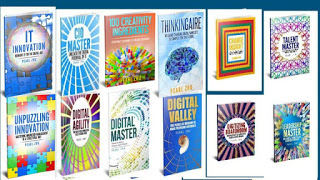Pearl Zhu's Blog, page 1262
January 9, 2017
The Monthly CIO Debates Collection: The IT New Year Self-Evaluation Jan, 2017
Debating is not for stimulating conflicts, but for brainstorming better ways to do things.
 Due to the changing nature of technology, IT leadership role also continues to involve & shift the focus, to move up the maturity level. More and more CIOs are requested to take more responsibility and many CIOs present the breadth of leadership competency. The proactive IT debates help IT leaders to brainstorm innovative and better ways to do things, and improve management capabilities. Here are the monthly CIO debates collections for Jan. 2017
Due to the changing nature of technology, IT leadership role also continues to involve & shift the focus, to move up the maturity level. More and more CIOs are requested to take more responsibility and many CIOs present the breadth of leadership competency. The proactive IT debates help IT leaders to brainstorm innovative and better ways to do things, and improve management capabilities. Here are the monthly CIO debates collections for Jan. 2017
The Two Sides of IT: Which Side is More Important? The forward-looking IT organizations are on the journey of digital transformation. The challenge is having a harmonized vision about overall IT capabilities and maturities, and which role IT should, or can play in the digital organization. There are front end and back end of the IT department. The front end of IT is value-added, to drive the business’s digital transformation, and the back end of the IT is fundamental, operational driven and keep the lights on. From IT management and digital transformation perspective, how to run two sides of IT smoothly, via setting the right principles and developing the next practices?
Is IT an Enabler or an Obstacle to Getting Things Done in Organizations In many organizations, IT has been perceived as a controller, a cost center, or even an obstacle to getting things done in the business. What’s the reality of your IT organization? How do you get the non-IT stakeholders to recognize and support the notion that IT and Business are not separate or independent departments? How do you get all stakeholders (IT and non-IT) to encourage the notion that IT and business need to work together to be successful? How do you get non-IT stakeholders to focus on collaboration, transparency, respect, and providing clear leadership?
When Should IT Lead, When Should IT Follow? More often than not, technology is the catalyst for driving business change and digital transformation, however, in most of the companies, IT is still perceived as an order taker and support function, and most of IT organizations get stuck at the lower level of maturity for functional alignment or enabler. So IT is at a crossroad: Shall IT lead or follow? Should IT leadership rock the boat or just keep it afloat? And how to run digital IT with high speed and agility?
Good Innovation, Bad Innovation: How to Discern It Innovation is the light every business is pursuing, and there is no surprise that the average success rate of Innovation Management is very low. The good innovation can leap the business to the next level of prosperity, and the bad innovation can fail the business in a fatal way. So how to set the criteria, make a clear discernment, and manage innovation more effectively?
 How Should CIOs respond to endless internal customer demand for IT solutionsThe “Future of CIO” Blog has reached 1.6 million page views with 3300+ blog posting in 59+ different categories of leadership, management, strategy, digitalization, change/talent, etc. blog posting. The content richness is not for its own sake, but to convey the vision and share the wisdom. Blogging is not about writing, but about thinking and innovating the new ideas; it’s not just about WHAT to say, but about WHY to say, and HOW to say it. It reflects the color and shade of your thought patterns, and it indicates the peaks and curves of your thinking waves. Unlike pure entertainment, quality and professional content takes time for digesting, contemplation and engaging, and therefore, it takes the time to attract the "hungry minds" and the "deep souls." It’s the journey to amplify diverse voices and deepen digital footprints, and it's the way to harness your innovative spirit.
How Should CIOs respond to endless internal customer demand for IT solutionsThe “Future of CIO” Blog has reached 1.6 million page views with 3300+ blog posting in 59+ different categories of leadership, management, strategy, digitalization, change/talent, etc. blog posting. The content richness is not for its own sake, but to convey the vision and share the wisdom. Blogging is not about writing, but about thinking and innovating the new ideas; it’s not just about WHAT to say, but about WHY to say, and HOW to say it. It reflects the color and shade of your thought patterns, and it indicates the peaks and curves of your thinking waves. Unlike pure entertainment, quality and professional content takes time for digesting, contemplation and engaging, and therefore, it takes the time to attract the "hungry minds" and the "deep souls." It’s the journey to amplify diverse voices and deepen digital footprints, and it's the way to harness your innovative spirit.
Follow us at: @Pearl_Zhu
 Due to the changing nature of technology, IT leadership role also continues to involve & shift the focus, to move up the maturity level. More and more CIOs are requested to take more responsibility and many CIOs present the breadth of leadership competency. The proactive IT debates help IT leaders to brainstorm innovative and better ways to do things, and improve management capabilities. Here are the monthly CIO debates collections for Jan. 2017
Due to the changing nature of technology, IT leadership role also continues to involve & shift the focus, to move up the maturity level. More and more CIOs are requested to take more responsibility and many CIOs present the breadth of leadership competency. The proactive IT debates help IT leaders to brainstorm innovative and better ways to do things, and improve management capabilities. Here are the monthly CIO debates collections for Jan. 2017
The Two Sides of IT: Which Side is More Important? The forward-looking IT organizations are on the journey of digital transformation. The challenge is having a harmonized vision about overall IT capabilities and maturities, and which role IT should, or can play in the digital organization. There are front end and back end of the IT department. The front end of IT is value-added, to drive the business’s digital transformation, and the back end of the IT is fundamental, operational driven and keep the lights on. From IT management and digital transformation perspective, how to run two sides of IT smoothly, via setting the right principles and developing the next practices?
Is IT an Enabler or an Obstacle to Getting Things Done in Organizations In many organizations, IT has been perceived as a controller, a cost center, or even an obstacle to getting things done in the business. What’s the reality of your IT organization? How do you get the non-IT stakeholders to recognize and support the notion that IT and Business are not separate or independent departments? How do you get all stakeholders (IT and non-IT) to encourage the notion that IT and business need to work together to be successful? How do you get non-IT stakeholders to focus on collaboration, transparency, respect, and providing clear leadership?
When Should IT Lead, When Should IT Follow? More often than not, technology is the catalyst for driving business change and digital transformation, however, in most of the companies, IT is still perceived as an order taker and support function, and most of IT organizations get stuck at the lower level of maturity for functional alignment or enabler. So IT is at a crossroad: Shall IT lead or follow? Should IT leadership rock the boat or just keep it afloat? And how to run digital IT with high speed and agility?
Good Innovation, Bad Innovation: How to Discern It Innovation is the light every business is pursuing, and there is no surprise that the average success rate of Innovation Management is very low. The good innovation can leap the business to the next level of prosperity, and the bad innovation can fail the business in a fatal way. So how to set the criteria, make a clear discernment, and manage innovation more effectively?
 How Should CIOs respond to endless internal customer demand for IT solutionsThe “Future of CIO” Blog has reached 1.6 million page views with 3300+ blog posting in 59+ different categories of leadership, management, strategy, digitalization, change/talent, etc. blog posting. The content richness is not for its own sake, but to convey the vision and share the wisdom. Blogging is not about writing, but about thinking and innovating the new ideas; it’s not just about WHAT to say, but about WHY to say, and HOW to say it. It reflects the color and shade of your thought patterns, and it indicates the peaks and curves of your thinking waves. Unlike pure entertainment, quality and professional content takes time for digesting, contemplation and engaging, and therefore, it takes the time to attract the "hungry minds" and the "deep souls." It’s the journey to amplify diverse voices and deepen digital footprints, and it's the way to harness your innovative spirit.
How Should CIOs respond to endless internal customer demand for IT solutionsThe “Future of CIO” Blog has reached 1.6 million page views with 3300+ blog posting in 59+ different categories of leadership, management, strategy, digitalization, change/talent, etc. blog posting. The content richness is not for its own sake, but to convey the vision and share the wisdom. Blogging is not about writing, but about thinking and innovating the new ideas; it’s not just about WHAT to say, but about WHY to say, and HOW to say it. It reflects the color and shade of your thought patterns, and it indicates the peaks and curves of your thinking waves. Unlike pure entertainment, quality and professional content takes time for digesting, contemplation and engaging, and therefore, it takes the time to attract the "hungry minds" and the "deep souls." It’s the journey to amplify diverse voices and deepen digital footprints, and it's the way to harness your innovative spirit.Follow us at: @Pearl_Zhu
Published on January 09, 2017 22:31
The Next Practices to Elevate Digital IT for the New Year
 The new year has kicked off, and the IT digital roadmap has been built up for many IT organizations. But what are the best and next practice to elevate IT? The new IT playbook isn't for the faint of heart. CIOs need to rise above the status quo and take on a new set of practices and activities that have them involved in the strategy development process from the get-go. Because running digital IT to enforce the strategic focus and harness business competency requires thinking forward and thoughtful planning, being innovative and experimental to create previously unconsidered solutions, and fine-tune the underlying business functions and capabilities to achieve high performance.
The new year has kicked off, and the IT digital roadmap has been built up for many IT organizations. But what are the best and next practice to elevate IT? The new IT playbook isn't for the faint of heart. CIOs need to rise above the status quo and take on a new set of practices and activities that have them involved in the strategy development process from the get-go. Because running digital IT to enforce the strategic focus and harness business competency requires thinking forward and thoughtful planning, being innovative and experimental to create previously unconsidered solutions, and fine-tune the underlying business functions and capabilities to achieve high performance.
Practice interdisciplinary management: In the industrial age, the majority of organizations were run in the silo mentality, the hierarchical management style intends to improve functional efficiency and keep things under control. However, nowadays, digital means flow, the mind flow, information flow, idea flow and business flow, across the functional border, and circle around the digital ecosystem. Hence, interdisciplinary management becomes a more practical approach to accelerate the digital paradigm shift. It is important to understand that dynamic business development is multifaceted, and it is crucial for gaining the knowledge necessary to understand and manage holistic digital ecosystems. To engage and function in a dynamic digital environments, it requires fundamentally different mindsets and paradigms such as accepting that influence is attainable, but control is not. Today’s digital leaders, especially CIOs are orchestrators who need to set the right tones, run a real time high-responsive digital organization, and drive the digital transformation synchronously. You can't expect most of the individuals to fully develop such broad-based concepts, it takes the team effort, and more importantly, team coordination and collaboration. Not just an average team with the homogeneous setting, but the high-performance team with complementary mindsets, skills, capabilities, and experiences.
Build Innovation Framework: “Doing more with innovation” will continue to be the digital mantra of IT organization. Digital innovation has an expanded spectrum to include both “hard innovation” such as products/services/business model/process innovation, and “soft innovation,” such as leadership/management innovation, communication innovation, etc. It is important to build a practical innovation framework and manage a balanced innovation portfolio in as structural way. Innovation management system includes policies, structure, and program that innovation leaders and managers can apply to drive innovation systematically. A defined structure is essential to managing innovation in an organization, but there's no one size fits all formula, and there is no single structure that will work in every organization. Trying to apply overly rigid structure applies limits to unleash full innovation potential. More precisely, you don't structure innovation to limit its potential, but build an innovation framework to keep focus, leverage the talent and resources to maximize its potential. If the structure is meant in a methodological sense, then the structure is needed. You need to make sure, that your company has a steady flow of fresh ideas floating in your innovation pipeline, and, therefore, you need a methodological platform that allows you to do that. You apply principles of approach and vary the resource and tool mix by the ever-changing environment, in order to manage innovation effectively and make a continuous delivery.
 Simplifying, optimizing, and digitizing to improve digital IT maturity: Apply a digital management philosophy and drive changes through the organization, consolidate, integrate and optimize IT asset accordingly, so that there are deliverables that provide benefit to the business at the shorter delivery cycle. IT digitalization is the well-planned journey, it is about managing application lifecycle, reassess any systems that require extra IT effort; consolidate, streamline and leverage the lightweight digital technologies; tighten coordination with vendors and partners, to continually simplifying and optimizing. Apply simplicity as a management principle to manage change effectively. Simplicity brings speed, clarity, flexibility, and productivity. Externally simplicity is often directly proportional to internally complexity. Run, grow and transformation, simplify unproductive complexity and streamline limited resources on higher prioritized business initiatives to make competitive business advantage.
Simplifying, optimizing, and digitizing to improve digital IT maturity: Apply a digital management philosophy and drive changes through the organization, consolidate, integrate and optimize IT asset accordingly, so that there are deliverables that provide benefit to the business at the shorter delivery cycle. IT digitalization is the well-planned journey, it is about managing application lifecycle, reassess any systems that require extra IT effort; consolidate, streamline and leverage the lightweight digital technologies; tighten coordination with vendors and partners, to continually simplifying and optimizing. Apply simplicity as a management principle to manage change effectively. Simplicity brings speed, clarity, flexibility, and productivity. Externally simplicity is often directly proportional to internally complexity. Run, grow and transformation, simplify unproductive complexity and streamline limited resources on higher prioritized business initiatives to make competitive business advantage.
Either setting digital principles or developing the best and next practices, IT leaders should remember that IT is about the Information, and focus on being a solution-driven business enabler and innovation-focused game-changer. Being innovative and optimized means IT needs to always in a continuous improvement mode to explore the better way, leverage limited resources, and focus on reaching overall agility and maturity.
Follow us at: @Pearl_Zhu
Published on January 09, 2017 22:25
January 8, 2017
The “CIO Master” Monthly Book Tuning: Running a Multifaceted Digital IT Jan. 2017
Digital IT needs to become more dynamic and innovative to be a pathfinder for the digital transformation.
 Modern CIOs have many personas and face great challenges. It is not sufficient to only keep the light on. Regardless of which industry or the nature of organization you are in, being a digital leader will need to master the art of creating unique, differentiating value from piles of commoditized technologies, but more specifically, what are the digital-savvy CIOs doing to run IT as a business growth engine and digital transformer? Here is the monthly “CIO Master” Book Tuning.
Modern CIOs have many personas and face great challenges. It is not sufficient to only keep the light on. Regardless of which industry or the nature of organization you are in, being a digital leader will need to master the art of creating unique, differentiating value from piles of commoditized technologies, but more specifically, what are the digital-savvy CIOs doing to run IT as a business growth engine and digital transformer? Here is the monthly “CIO Master” Book Tuning.
Running a Multifaceted Digital IT 2017 Five dimensions of IT Digital Transformation Modern IT organizations play a critical role in driving the digital transformation of the entire company. The CIO has to look forward and actively position the business in the right place to take full advantage of opportunities and emergent digital technology trends. DRIVING is not a passive activity. The role of modern CIO is to identify and blend the processes and practices that information and technology can assist and shape the business by linking all digital aspects together to enforce the value creation and drive digital transformation from multidimensional perspectives.Does IT Work in the System or on the System to Drive Digital Transformation: Information and technology catalyze today's digital businesses, either disrupt or being disrupted. IT is at an inflection point to lead the organizational level digital transformation. Nowadays, IT can no longer run in the silo, IT is the business. Because information brings about business ideas; business ideas generate lots of information. Information Systems are the backbone and provide valuable information for key decision making and problems solving, And IT needs to contribute to the business growth, innovation, and customer experience optimization. So in order to drive digital transformation, should your IT organization work in the system or on the system to unleash the full digital potential and improve the organizational maturity?
The Multitude of IT focus at the Era of Digital Renaissance? Digital transformation represents a break with the past, with a high level of impact and complexity. Transformation efforts need to be undertaken as the means of getting to a defined different capability to accomplish a set of defined business goals. IT plays a critical role in catalyzing the digital shift because IT is a business integrator and capability builder of the organization. At the digital age, CIOs need to be play multiple roles, to run IT with the multitude of focus at the era of digital renaissance.
The Perception, Profit, and Partnership of Digital IT: Digital means flow - data flow, information flow, and mind flow. Digital organizations have to adapt to the continuous changes and business dynamic in striving to become digital masters. Digital transformation is a natural process and rather effortless to maintain, The bottom line is how well the organization is being influenced by varying business factors such as communication, structure, management methodology or approach. IT transformation is an integrated part of the digital transformation of the business. IT transformation is on the horizon when it is designed to change, from a static support function to an innovative growth engine?
 Running Digital IT to Harness Business Competency? At the dawn of the digital era, innovation threatens to tear down legacy systems and practices just as it generates new opportunities, IT organizations are nonetheless resistant to change. It's natural to fear the unknown, question the unproven, be skeptical of the latest digital trends and be paradoxical about digital disruptions. However, change is inevitable, in fact, forward-looking businesses are empowering their IT organization to drive changes and lead the digital transformation. The new IT rulebook isn't for the faint of heart. CIOs need to rise above the status quo and take on a new set of activities that have them involved in the strategy development process from the get-go. Because running digital IT to enforce the strategic focus and harness business competency requires thinking beyond, altering or changing the frame of reference to create previously unconsidered solutions, and make a shift from inside-out operation-driven to outside-in customer-focused.?
Running Digital IT to Harness Business Competency? At the dawn of the digital era, innovation threatens to tear down legacy systems and practices just as it generates new opportunities, IT organizations are nonetheless resistant to change. It's natural to fear the unknown, question the unproven, be skeptical of the latest digital trends and be paradoxical about digital disruptions. However, change is inevitable, in fact, forward-looking businesses are empowering their IT organization to drive changes and lead the digital transformation. The new IT rulebook isn't for the faint of heart. CIOs need to rise above the status quo and take on a new set of activities that have them involved in the strategy development process from the get-go. Because running digital IT to enforce the strategic focus and harness business competency requires thinking beyond, altering or changing the frame of reference to create previously unconsidered solutions, and make a shift from inside-out operation-driven to outside-in customer-focused.?
The “Future of CIO” Blog has reached 1.6 million page views with about #3300th blog posting in 59+ different categories of leadership, management, strategy, digitalization, change/talent, etc. The content richness is not for its own sake, but to convey the vision and share the wisdom. Blogging is not about writing, but about thinking and innovating the new ideas; it’s not just about WHAT to say, but about WHY to say, and HOW to say it. It reflects the color and shade of your thought patterns, and it indicates the peaks and curves of your thinking waves. Unlike pure entertainment, quality and professional content takes time for digesting, contemplation and engaging, and therefore, it takes time to attract the "hungry minds" and the "deep souls." It’s the journey to amplify diverse voices and deepen digital footprints, and it's the way to harness your innovative spirit.
Follow us at: @Pearl_Zhu
 Modern CIOs have many personas and face great challenges. It is not sufficient to only keep the light on. Regardless of which industry or the nature of organization you are in, being a digital leader will need to master the art of creating unique, differentiating value from piles of commoditized technologies, but more specifically, what are the digital-savvy CIOs doing to run IT as a business growth engine and digital transformer? Here is the monthly “CIO Master” Book Tuning.
Modern CIOs have many personas and face great challenges. It is not sufficient to only keep the light on. Regardless of which industry or the nature of organization you are in, being a digital leader will need to master the art of creating unique, differentiating value from piles of commoditized technologies, but more specifically, what are the digital-savvy CIOs doing to run IT as a business growth engine and digital transformer? Here is the monthly “CIO Master” Book Tuning.
Running a Multifaceted Digital IT 2017 Five dimensions of IT Digital Transformation Modern IT organizations play a critical role in driving the digital transformation of the entire company. The CIO has to look forward and actively position the business in the right place to take full advantage of opportunities and emergent digital technology trends. DRIVING is not a passive activity. The role of modern CIO is to identify and blend the processes and practices that information and technology can assist and shape the business by linking all digital aspects together to enforce the value creation and drive digital transformation from multidimensional perspectives.Does IT Work in the System or on the System to Drive Digital Transformation: Information and technology catalyze today's digital businesses, either disrupt or being disrupted. IT is at an inflection point to lead the organizational level digital transformation. Nowadays, IT can no longer run in the silo, IT is the business. Because information brings about business ideas; business ideas generate lots of information. Information Systems are the backbone and provide valuable information for key decision making and problems solving, And IT needs to contribute to the business growth, innovation, and customer experience optimization. So in order to drive digital transformation, should your IT organization work in the system or on the system to unleash the full digital potential and improve the organizational maturity?
The Multitude of IT focus at the Era of Digital Renaissance? Digital transformation represents a break with the past, with a high level of impact and complexity. Transformation efforts need to be undertaken as the means of getting to a defined different capability to accomplish a set of defined business goals. IT plays a critical role in catalyzing the digital shift because IT is a business integrator and capability builder of the organization. At the digital age, CIOs need to be play multiple roles, to run IT with the multitude of focus at the era of digital renaissance.
The Perception, Profit, and Partnership of Digital IT: Digital means flow - data flow, information flow, and mind flow. Digital organizations have to adapt to the continuous changes and business dynamic in striving to become digital masters. Digital transformation is a natural process and rather effortless to maintain, The bottom line is how well the organization is being influenced by varying business factors such as communication, structure, management methodology or approach. IT transformation is an integrated part of the digital transformation of the business. IT transformation is on the horizon when it is designed to change, from a static support function to an innovative growth engine?
 Running Digital IT to Harness Business Competency? At the dawn of the digital era, innovation threatens to tear down legacy systems and practices just as it generates new opportunities, IT organizations are nonetheless resistant to change. It's natural to fear the unknown, question the unproven, be skeptical of the latest digital trends and be paradoxical about digital disruptions. However, change is inevitable, in fact, forward-looking businesses are empowering their IT organization to drive changes and lead the digital transformation. The new IT rulebook isn't for the faint of heart. CIOs need to rise above the status quo and take on a new set of activities that have them involved in the strategy development process from the get-go. Because running digital IT to enforce the strategic focus and harness business competency requires thinking beyond, altering or changing the frame of reference to create previously unconsidered solutions, and make a shift from inside-out operation-driven to outside-in customer-focused.?
Running Digital IT to Harness Business Competency? At the dawn of the digital era, innovation threatens to tear down legacy systems and practices just as it generates new opportunities, IT organizations are nonetheless resistant to change. It's natural to fear the unknown, question the unproven, be skeptical of the latest digital trends and be paradoxical about digital disruptions. However, change is inevitable, in fact, forward-looking businesses are empowering their IT organization to drive changes and lead the digital transformation. The new IT rulebook isn't for the faint of heart. CIOs need to rise above the status quo and take on a new set of activities that have them involved in the strategy development process from the get-go. Because running digital IT to enforce the strategic focus and harness business competency requires thinking beyond, altering or changing the frame of reference to create previously unconsidered solutions, and make a shift from inside-out operation-driven to outside-in customer-focused.?The “Future of CIO” Blog has reached 1.6 million page views with about #3300th blog posting in 59+ different categories of leadership, management, strategy, digitalization, change/talent, etc. The content richness is not for its own sake, but to convey the vision and share the wisdom. Blogging is not about writing, but about thinking and innovating the new ideas; it’s not just about WHAT to say, but about WHY to say, and HOW to say it. It reflects the color and shade of your thought patterns, and it indicates the peaks and curves of your thinking waves. Unlike pure entertainment, quality and professional content takes time for digesting, contemplation and engaging, and therefore, it takes time to attract the "hungry minds" and the "deep souls." It’s the journey to amplify diverse voices and deepen digital footprints, and it's the way to harness your innovative spirit.
Follow us at: @Pearl_Zhu
Published on January 08, 2017 22:53
The Effectiveness and Efficiency of Decision Making
 Making a decision is one of the significant tasks for business leadership, however, the high ratio of strategic decisions have been made poorly and cause the catastrophic effect. There is fuzziness in the decisions because there is fuzziness in conflicting criteria. An effective decision can be defined as an action you take that is logically consistent with the alternative you perceive, the information you get and the preference you have. But how to make effective decisions in the face of today’s complexity and uncertainty.
Making a decision is one of the significant tasks for business leadership, however, the high ratio of strategic decisions have been made poorly and cause the catastrophic effect. There is fuzziness in the decisions because there is fuzziness in conflicting criteria. An effective decision can be defined as an action you take that is logically consistent with the alternative you perceive, the information you get and the preference you have. But how to make effective decisions in the face of today’s complexity and uncertainty.
Well align People, Process, and Technology in Decision Making Scenario: All decisions were difficult and time-consuming as goals and alternatives were continuously being rehashed, debated and tweaked but no one wanted to actually make a decision. Therefore, an effective decision-making scenario takes well alignment of people, process, and technology, implementing a decision-making software tool does make decision making more systematic: After the initial learning curve, the group decision-making sessions are short, productive and well documented. The process organized through the software helps organize the goals, the criteria and provides a sensitivity analysis tool. As a result, the debate in the decision-making sessions cut out the bickering about the input and more about expected outcome to meet the goals of the group. The group members believe they are making better decisions and they will often go back to review the decisions, update the outcome and comment on what worked and what needs to be worked on. Many are using the decision tool as a "corporate knowledge base" to help make a decision in the future.
The good decision making shall consider both effectiveness and efficiency: Science, technology, and economics focus on efficiency, but not effectiveness. The difference between efficiency and effectiveness is important to an understanding of transformative leadership. Even with the best systems and processes, there are no guarantees that you will make good decisions, indeed the fact that something requires a decision will mean that there will be a bunch of associated risks to manage. A decision is a plan to change something in your current situation. A"decision" has lots of connotations of finality. What seems to mark those good problems solvers out from others is their ability to frame issues, problems, and decision options and turn them into potential opportunities, tangible outcomes, and inspirational change and transformation. Efficiency is a measure of how well resources are used to achieve ends; it is value-free. Effectiveness is efficiency weighted by the values of the ends achieved; it is value-full.
Brainstorm possible options and alternative solutions: There is too often a tendency to take a one-size-fits-all approach to decision making, which includes a linear and static decision which commits to a singular path. Decision-making today needs to take a systematic approach, but via nonlinear, collective thinking, the mix of analytics and intuition, and group contribution. Consider and compare the advantages and disadvantages of all options. Select the best option - avoid vagueness or indecisiveness. The thing, however, that the human brain cannot do, is to do a comparative assessment of many decision criteria - both quantitative and subjective, concurrently across many options, initiatives or programs etc, but the advanced decision intelligence tools can help. When leveraging the tool weighing tradeoffs, it's important that the team has determined the relative importance of each factor. Teams. Especially with the heterogeneous team setting, work because they bring different perspectives and knowledge to the table. They help to balance out the biases that from which the poor decisions are made. A decision is arguably a choice between two or more options. The greater majority of these options are circumstantially provided. One alternative may have a lot more strengths than another, but all those strengths together may not be nearly as important as the one or two strengths that another alternative has. So effective decision making needs to well blend both information and intuition; think fast and slow accordingly.
Any decision made needs to be applicable in a timely manner: Decisions are necessary as a result of limited resources in time, knowledge, capital, and people. There is no such thing as a perfect decision, but it is always crucial to make the timely decision in order to take the best action you could. People with different personalities approach decision making in different ways. And some have difficulty making any decision at all, which is in and of itself a passive decision “not to decide.” Making the decision in a timely manner requires resource awareness. Resource limitations are significant and decision makers who are not cognoscente of what they can or cannot do will always make a bad decision. Effective resource allocation and utilization is an important factor for a timely decision making. Sometimes internal factors which may influence the decision process include, such as the goals of the decision maker, decision situation, decision context, relevant knowledge, as well as the organizational capabilities and resources. On the other hand, external factors can influence strategic decision-making as well, including technology factors, political and legal conditions, and competition and consumer demands.
 “Fast Decision, Slow Decision”: Fast decisions are made of necessity. But a condition of benefiting from considered decisions is having a good decision -making the process to use the time effectively. There’s research into leadership that basically says, "If speed matters, you need someone with experience - they will make better decisions. If speed doesn't matter, you need someone with "smarts" as then they will have the time to make better decisions than you would get from the evidence alone. Some say, cognitively the shorter time for decision making helps make the decision (right or wrong) more concrete.
“Fast Decision, Slow Decision”: Fast decisions are made of necessity. But a condition of benefiting from considered decisions is having a good decision -making the process to use the time effectively. There’s research into leadership that basically says, "If speed matters, you need someone with experience - they will make better decisions. If speed doesn't matter, you need someone with "smarts" as then they will have the time to make better decisions than you would get from the evidence alone. Some say, cognitively the shorter time for decision making helps make the decision (right or wrong) more concrete.Either decision fast or decision slow; the individual decision or group decision, it takes right information, organized process, efficient decision analytics tool, timely feedback, and follow the decision principles in order to make decision scenario more productive and effective.Follow us at: @Pearl_Zhu
Published on January 08, 2017 22:49
How to Overcome Barriers in Digital Transformation
 Organizations large and small are on the journey of the digital transformation. Transformation is the leapfrogging changes, and it is structural. Change is functional. Both are manageable. However, more than two-thirds of the Change Management initiatives fail to achieve the expected business results. There are many roadblocks and numerous pitfalls on the way. More specifically, what are the barriers and how to overcome them in order to manage change and digital transformation seamlessly?
Organizations large and small are on the journey of the digital transformation. Transformation is the leapfrogging changes, and it is structural. Change is functional. Both are manageable. However, more than two-thirds of the Change Management initiatives fail to achieve the expected business results. There are many roadblocks and numerous pitfalls on the way. More specifically, what are the barriers and how to overcome them in order to manage change and digital transformation seamlessly?
Lack of leadership vision: Lack of the clear vision is one of the biggest roadblocks on the business transformation journey. Leadership vision is to be the guiding light for the change management, to clarify the very reason - WHY do you want to change, and the “destination” look like. Being a leader means giving people confidence on where to go and how to get there, motivating them and also stretching them to live to their full potential, both individually and as members of a high performing team. Transformation is the change, but on a grand level, at the level of the system, differentiate in terms of the end result on a systemic level. Leadership vision is to serve as an enabler, being coherent with his/her organization's vision. An organization needs to be prepared to effectively and efficiently absorb and accept change in all its forms. By taking the systematic approach, the digital transformation can take the pace steadily in an organization in which change does not disrupt and interfere with business as usual; for which the ability to evolve, adapt and innovate is business as usual.
Fear of the unknown; fear of failures; and the blind spots on the way: Be cognizant of unknown. Organizational change is always difficult, and many organizations have the symptom of “change fatigue.” Complacency - Leaders often miss the big picture and become complacent! Comfort with the status quo. Hence, communication is important to let people figure out “What’s in Me,” and the easier change may become. It is also important to build the culture of learning and risk tolerance and keep the opportunity open for defining and leveraging current strengths during the change process. Future, Most teams operate with an incomplete and relatively small view of the world. Thus, too often in an effort to keep moving forward, the blind spots cloud their vision and they jump to the wrong conclusions. The blind spots, either strategic one or operational one, are perhaps inevitable. So as the change leader, you have to be humble to realize there are many things you know you don’t know and perhaps even more which you don't know what you don't know. Until that happens, you will continue on the lives in blindness. Continue to see the importance of dealing with blind spots by learning how to be quick to listen, slow to speak, and slow to anger, be hungry for the insight and be skillful to frame the right questions and behold to the metrics.
Silo thinking and unhealthy internal competitions: If the majority of organizations at the industrial age are manipulated by silo thinking and hierarchical style, which often cause unhealthy internal competitions for limited resources; with silo mentality, organizations lose their collaborative advantage as they are being over managed and under led, remain disconnected, hoard knowledge and power within silos, have change inertia, and do not have the competence to collaborate in the long term. But nowadays, digital means increasing speed of changes, holism, and interconnectivity. Building an evolving digital organization is to advocate the concept of “business as a whole is superior to the sum of pieces.” It’s important for leaders and managers about learning how to think the systemic wholeness, in terms of how to break down silos between subcultures, shared goals. Change is the team effort, encourage all employees to provide feedback, ask questions, and participate change proactively, to expand their view of the business and gain a holistic understanding of changes. It is imperative that we be willing to seek out help, break down silos, and harness cross-functional collaboration as we work to generate new ideas or solve problems.
Change too slowly to too costly: Change is expensive and change too slowly will cause the business losing the growth opportunity or get hit by the risks. “Changeability” becomes an important measure to assess a person or a business’s potential, agility, and maturity. Unfortunately, change is not as easy as it sounds, and change is costly. Change Management in many organizations seems to be at the crossroad. Many times, teams have worked very hard to refine the processes involved with an initiative, but if change mechanism is not embedded into the holistic business management, or change is managed as the other layer of workload or an isolated effort, it could be too costly or drag down the productivity and lose the focus. The point is Change Management needs to always go hand in hand with strategy management, program, project management or talent management, with a clear business purpose and focus on getting it sustainable.
 The “comfort zone”: The more transparent about a change effort, the less uncertainty there will be about the effort. People respond in different ways to different situations. It is important to understand the psychology behind the changes, and help people “moving out of your comfort zone," which can be used at all levels and as a starting point for change. There is so much psychology in openness to new ideas and perspectives: There is not a one size fits all approach to addressing the different psychological responses to changes, and thereby reducing anxiety because there are different psychological perspectives. For example, there are those who think logically, others focus bigger picture, and others are a lot more emotional in their decision-making. It takes slightly different approaches, timescales, and skills to unlock the anxiety. Hence, change practitioners need to have good critical thinking skills, high level of adaptability, communication and engagement skills.
The “comfort zone”: The more transparent about a change effort, the less uncertainty there will be about the effort. People respond in different ways to different situations. It is important to understand the psychology behind the changes, and help people “moving out of your comfort zone," which can be used at all levels and as a starting point for change. There is so much psychology in openness to new ideas and perspectives: There is not a one size fits all approach to addressing the different psychological responses to changes, and thereby reducing anxiety because there are different psychological perspectives. For example, there are those who think logically, others focus bigger picture, and others are a lot more emotional in their decision-making. It takes slightly different approaches, timescales, and skills to unlock the anxiety. Hence, change practitioners need to have good critical thinking skills, high level of adaptability, communication and engagement skills.
Digital transformation is a strategic imperative, and change is inevitable. To clear the path, whether that be the elimination of obstacles or to provide coaching and guidance, change leaders need to have a clear vision, the comprehensive planning, the robust, but not overly rigid process, and the motivational change agents, to make change fun and sustainable, so that the talent employees are limited only by their imagination.
Follow us at: @Pearl_Zhu
Published on January 08, 2017 22:46
January 7, 2017
The Popular Quotes Collection of “Digital Master” Book Series
 “Digital Master” is the series of guidebooks (12+ books) with five pillars to perceive the multifaceted impact digital is making to the business and our society, help forward-thinking organizations navigate through the digital journey in a systematic way, and avoid “rogue digital.” Here is the set of popular quotes for conveying the digital vision and sharing the unique insight about the digital transformation.
“Digital Master” is the series of guidebooks (12+ books) with five pillars to perceive the multifaceted impact digital is making to the business and our society, help forward-thinking organizations navigate through the digital journey in a systematic way, and avoid “rogue digital.” Here is the set of popular quotes for conveying the digital vision and sharing the unique insight about the digital transformation.
 It Innovation: Reinvent It for the Digital Age by Pearl Zhu
It Innovation: Reinvent It for the Digital Age by Pearl Zhu
“Innovation becomes simply “creating value by solving simple or complex problems.” ― Pearl Zhu, It Innovation: Reinvent It for the Digital Age
“To strengthen the IT-business link, it takes more resource to doing innovation, not just IT innovation, but business innovation.” ― Pearl Zhu, It Innovation: Reinvent It for the Digital Age
“The industrial-based enterprise of the 20th century had run out of gas, and the digital enterprise of the 21st century has the new characteristics and DNA of innovation.” ― Pearl Zhu, It Innovation: Reinvent It for the Digital Age
“Innovation becomes simply “creating value by solving simple or complex problems.” ― Pearl Zhu, It Innovation: Reinvent It for the Digital Age
“Silo thinking creates blind spots and enlarges IT-business gaps.” ― Pearl Zhu, It Innovation: Reinvent It for the Digital Age
 Thinkingaire: 100 Game-Changing Digital Mindsets to Compete for the Future
Thinkingaire: 100 Game-Changing Digital Mindsets to Compete for the Future
Wisdom is the intelligent use of our knowledge, whereas sensibility is an intelligent use of our judgment.” ― Pearl Zhu, Thinkingaire: 100 Game-Changing Digital Mindsets to Compete for the Future
“Clarity is a perception; it’s an emotional alignment of thoughts, intuitions, inclinations, expression and expectations.” ― Pearl Zhu, Thinkingaire: 100 Game-Changing Digital Mindsets to Compete for the Future
“Learning is the way to keep your mind flowing, and hence your life flowing” ― Pearl Zhu, Thinkingaire: 100 Game-Changing Digital Mindsets to Compete for the Future
“A flexible mind has a better chance to think differently and take a unique path in the life journey.” ― Pearl Zhu, Thinkingaire: 100 Game-Changing Digital Mindsets to Compete for the Future
“Open the mind to be on a path to a better version of yourself.” ― Pearl Zhu, Thinkingaire: 100 Game-Changing Digital Mindsets to Compete for the Future
 CIO Master: Unleash the Digital Potential of It b
CIO Master: Unleash the Digital Potential of It b
“The future of digital organizations is to be complex enough to act intelligently and nimble enough to adapt to the change promptly.” ― Pearl Zhu, CIO Master: Unleash the Digital Potential of It
“IT needs to be running in a proactive digital mode, rather than in a reactive industrial mode.” ― Pearl Zhu, CIO Master: Unleash the Digital Potential of It
“IT can coordinate all necessary business elements, either hard or soft, to orchestrate a digital symphony.” ― Pearl Zhu, CIO Master: Unleash the Digital Potential of It
“Change Management can become more successful with people at the core of change, the cause of changes and the purpose of change.” ― Pearl Zhu, CIO Master: Unleash the Digital Potential of It
“CIOs need to be IT evangelists and learn to sell, speak business.” ― Pearl Zhu, CIO Master: Unleash the Digital Potential of It
 Digitizing Boardroom: The Multifaceted Aspects of Digital Ready Boards by Pearl Zhu
Digitizing Boardroom: The Multifaceted Aspects of Digital Ready Boards by Pearl Zhu
“Digital transformation represents a break with the past, having a high level of impact and complexity.” ― Pearl Zhu, Digitizing Boardroom: The Multifaceted Aspects of Digital Ready Boards
“It is what the “I” stands for - Information, Innovation, Insight, Improvement, or Influence, that needs to be represented by CIOs in the Boardroom.” ― Pearl Zhu, Digitizing Boardroom: The Multifaceted Aspects of Digital Ready Boards
The purpose of the governing body, or board of directors, is to direct and guide the organization in the right direction” ― Pearl Zhu, Digitizing Boardroom: The Multifaceted Aspects of Digital Ready Boards
“The CIO is a serious partner in the inner circle to creating value-added strategies and enabling deeper insights into the opportunities IT can do.” ― Pearl Zhu, Digitizing Boardroom: The Multifaceted Aspects of Digital Ready Boards
“Sense and deal with problems in their smallest state, before they grow bigger and become fatal.” ― Pearl Zhu, Digitizing Boardroom: The Multifaceted Aspects of Digital Ready Boards
 Unpuzzling Innovation: Mastering Innovation Management in a Structural Way by Pearl Zhu
Unpuzzling Innovation: Mastering Innovation Management in a Structural Way by Pearl Zhu
“Innovation is to connect the dots - synthesizing that goes in one mind, and teamwork through collective insight.” ― Pearl Zhu, Unpuzzling Innovation: Mastering Innovation Management in a Structural Way
“Creativity is the ability to create novel value, and innovation is how to transform ideas and achieve their business value.” ― Pearl Zhu, Unpuzzling Innovation: Mastering Innovation Management in a Structural Way
“Digital innovation is a dynamic storybook that has intricate chapters, with a serendipitous cover, which can be flipped over to the next level, but it is a book that never ends.” ― Pearl Zhu, Unpuzzling Innovation: Mastering Innovation Management in a Structural Way
“The innovation classification is not just based on the required investments, or on the potential market, but on its evolution abilities.” ― Pearl Zhu, Unpuzzling Innovation: Mastering Innovation Management in a Structural Way
“Innovation is a question of ambition, and imagination, not a question of investment only.” ― Pearl Zhu, Unpuzzling Innovation: Mastering Innovation Management in a Structural Way
 Leadership Master: Five Digital Trends to Leap Leadership Maturity“Digital fit” should be first defined as “mind fit,” and then following with attitude fit and behavior fit.” ― Pearl Zhu, Leadership Master: Five Digital Trends to Leap Leadership Maturity“The creativity strength is like a spinning wheel, you need to figure out how to boost it up.” ― Pearl Zhu, Leadership Master: Five Digital Trends to Leap Leadership Maturity“Framing the right problem is equally or even more important than solving it.” ― Pearl Zhu, Leadership Master: Five Digital Trends to Leap Leadership Maturity“Leadership view is multidimensional with the full spectrum of colors.” ― Pearl Zhu, Leadership Master: Five Digital Trends to Leap Leadership MaturityFollow us at: @Pearl_Zhu
Leadership Master: Five Digital Trends to Leap Leadership Maturity“Digital fit” should be first defined as “mind fit,” and then following with attitude fit and behavior fit.” ― Pearl Zhu, Leadership Master: Five Digital Trends to Leap Leadership Maturity“The creativity strength is like a spinning wheel, you need to figure out how to boost it up.” ― Pearl Zhu, Leadership Master: Five Digital Trends to Leap Leadership Maturity“Framing the right problem is equally or even more important than solving it.” ― Pearl Zhu, Leadership Master: Five Digital Trends to Leap Leadership Maturity“Leadership view is multidimensional with the full spectrum of colors.” ― Pearl Zhu, Leadership Master: Five Digital Trends to Leap Leadership MaturityFollow us at: @Pearl_Zhu
Published on January 07, 2017 23:31
Three Aspects to Achieve Decision-Making Premium
 Decision making is a daily challenge for most business leaders and professionals because organizations become over-complex, hyper-connected, uncertain and ambiguous. What is more important to effecting good decisions within your organization? A sound process? How to achieve decision-making premium?
Decision making is a daily challenge for most business leaders and professionals because organizations become over-complex, hyper-connected, uncertain and ambiguous. What is more important to effecting good decisions within your organization? A sound process? How to achieve decision-making premium?
A sound process to frame decision is critical: Part of the problem is in the framing. You need a sound process to frame the decision, spec out your options, weigh them appropriately with the right people, and actually make a decision. The importance of the process becomes critical as decisions become more complex and involve more diverse stakeholders. If you hang around the word data, It’s the process. From an organizational and business optimization point of view - Process is the sequenced series of tasks. What do tasks need to be performed? Next, look at in which sequence these tasks should be performed to generate optimal value. Too many decisions do not have the ambitious performance outcomes that were intended.
The distinction between the decision quality and the outcome is important: If the decision-making process is well designed & well executed, you have the highest probability of getting the best outcome in the state of knowledge accessible at the time of decision. But lucks (and externalities) matter. A good process can still get adverse outcomes. All good process does decrease the risk of the wrong choice, not eliminate it. Too often "Bad Decision" is a judgment of outcome, not decision process. The decision is not necessarily bad, but the flow and sequence of the subsidiary decision implementations all encounter a different set of context dynamics. In fast moving competitive business environments, the shortcomings inherent in a clear current decision-making knowledge context and top-down vague strategic - 'me-tooism' - style decision-making all lack the much needed essential iterative process dynamics, where the decision is managed as the end effect not the beginning.Enabling scenario and forecasting to promote decision alternatives
 The commitment from decision-makers is important to achieve decision premium: That commitment is one that is difficult if the corporate culture is acrimonious and confrontational.t has to do with insufficient time to think carefully about important decisions. Always challenge the groups with the question: do you think management agrees to just do things without thinking, or would they value the fact that you put some effort in thinking over facts and observations more carefully. Identify with the need for decision making to include building commitment to execution. It includes involvement of some of the deployment team pretty early in the process, as the chosen alternative starts to emerge; and in getting the deployment team leader to sign on "for the duration".People often run away from accountability because they had a personal experience or they have observed others being treated poorly or unfairly when being held accountable for results. Often times when the results do not measure up to expectations. Consequently, they fear the realm of accountability and run for the hills. Unfortunately, such experiences are prevalent in many of organizational cultures which in turn creates the blame game, etc. Mature cultures take accountability for results and have pride in affecting the outcome good or bad. They learn and then move forward stronger and more robust than before.
The commitment from decision-makers is important to achieve decision premium: That commitment is one that is difficult if the corporate culture is acrimonious and confrontational.t has to do with insufficient time to think carefully about important decisions. Always challenge the groups with the question: do you think management agrees to just do things without thinking, or would they value the fact that you put some effort in thinking over facts and observations more carefully. Identify with the need for decision making to include building commitment to execution. It includes involvement of some of the deployment team pretty early in the process, as the chosen alternative starts to emerge; and in getting the deployment team leader to sign on "for the duration".People often run away from accountability because they had a personal experience or they have observed others being treated poorly or unfairly when being held accountable for results. Often times when the results do not measure up to expectations. Consequently, they fear the realm of accountability and run for the hills. Unfortunately, such experiences are prevalent in many of organizational cultures which in turn creates the blame game, etc. Mature cultures take accountability for results and have pride in affecting the outcome good or bad. They learn and then move forward stronger and more robust than before.Making a decision is a plan to change something in your current situation. Decision making is one of the most important and sophisticated activities for business leaders and professionals today, and at the strategic level, the outcome of decision making will directly make an impact on the survival or thriving of the business.Follow us at: @Pearl_Zhu
Published on January 07, 2017 23:27
Crafting a Digital IT Roadmap in the New Year
With a comprehensive IT roadmap, IT can leverage time, resource and talent wisely and run a high-effective organization seamlessly.
 Organizations large or small are on the journey of going digital. Building a digital-ready IT roadmap is a proactive approach to well prepare for the digital transformation. And the history reveals that IT needs to be understood and harnessed by all stakeholders, to fulfill its potential and highlight the strategic importance as a differentiator of companies. After the new year resolution, how to craft a high achievable and comprehensive IT roadmap to fulfill the digital vision?
Organizations large or small are on the journey of going digital. Building a digital-ready IT roadmap is a proactive approach to well prepare for the digital transformation. And the history reveals that IT needs to be understood and harnessed by all stakeholders, to fulfill its potential and highlight the strategic importance as a differentiator of companies. After the new year resolution, how to craft a high achievable and comprehensive IT roadmap to fulfill the digital vision?
The technical evolution roadmap is the outcome to mind gaps between "To-Be" and "As-Is": A key ingredient will be the expectations and requirements from the business management on how they expect IT to contribute to the overall business. Once you know that current state (the starting point) for both the business and IT and how well they interrelate and get a vision for the business, and then you can begin to put a vision together for IT. Conduct organizational level briefing and choose most suitable and acceptable approach. The stepwise process from here to there should include a rough timeline and should provide the business benefit each interim state provides. It should check and include (a) What do you have (processes, artifacts, staffing ) (b) What can you achieve in the time frame (leverage both short term 6 to 12 months or longer term 3-5 years) (c) What element do you add in which fiscal years, what benefit does it provide you and why were these selected over others? Etc.
Define more than one way of achieving the goal. For each approach, estimate costs, resources required, timelines, risks involved, and trends. The issue is the business context definition. The approach depends on the company’s business and the role that IT plays in defining its positioning in the market. It all starts with the CIO and IT leaders defining what exactly is a "core" IT need. To put simply, IT faces unprecedented opportunity to refine its reputation, also needs to take more responsibility as a true business partner. The trusted expert who understands a lot about the performance dynamics of the tech sector, and to be seen as a value-added participant in conversations regarding the need to increase profit, market penetration, reduce risk, and to increase the velocity/effectiveness of every dollar spent. It is how to leverage the resources and assets of the IT departments to create the optimal business value - which in the next step, will generate revenue growth, brand or increased market shares.
 Also, completed the gap analysis against "To-Be": Building the 'right' bridge between IT and business, closing the gap is about doing the basics right and managing prioritized / desired capabilities, you are good to define a roadmap for strategic (long term) / tactical (quick wins) timeline. Ultimately you'd want to recognize that what most businesses need is an IT capability, not "just" an IT department. It means IT should spend more resources upon crafting unique business capabilities and capturing business growth opportunities, beyond "keeping the lights on." When you place the "To-Be" state first, it creates a paradigm shift in your approach. Capabilities, barriers, risk, etc. will be quickly discovered. A roadmap should then typically contain or be informed by capabilities needed to get there. The old chestnut of core and noncore activities has come up until IT organizations are able to set the right priority, build the unique set of capabilities, and take the step-wise approach to implementing well-defined IT roadmap solidly.
Also, completed the gap analysis against "To-Be": Building the 'right' bridge between IT and business, closing the gap is about doing the basics right and managing prioritized / desired capabilities, you are good to define a roadmap for strategic (long term) / tactical (quick wins) timeline. Ultimately you'd want to recognize that what most businesses need is an IT capability, not "just" an IT department. It means IT should spend more resources upon crafting unique business capabilities and capturing business growth opportunities, beyond "keeping the lights on." When you place the "To-Be" state first, it creates a paradigm shift in your approach. Capabilities, barriers, risk, etc. will be quickly discovered. A roadmap should then typically contain or be informed by capabilities needed to get there. The old chestnut of core and noncore activities has come up until IT organizations are able to set the right priority, build the unique set of capabilities, and take the step-wise approach to implementing well-defined IT roadmap solidly.
The digital world is so information-intensive, technology needs will only expand, and most likely expand hyperbolically. The CIO should sit on the executive board, not because IT is important, but because it is business critical that the CIO and the IT department effectively catalyze, enables, and facilitates the business strategy and objectives, and ultimately drive digital transformation. With a comprehensive IT roadmap, IT can leverage time, resource and talent wisely and run a high-effective organization seamlessly.
Follow us at: @Pearl_Zhu
 Organizations large or small are on the journey of going digital. Building a digital-ready IT roadmap is a proactive approach to well prepare for the digital transformation. And the history reveals that IT needs to be understood and harnessed by all stakeholders, to fulfill its potential and highlight the strategic importance as a differentiator of companies. After the new year resolution, how to craft a high achievable and comprehensive IT roadmap to fulfill the digital vision?
Organizations large or small are on the journey of going digital. Building a digital-ready IT roadmap is a proactive approach to well prepare for the digital transformation. And the history reveals that IT needs to be understood and harnessed by all stakeholders, to fulfill its potential and highlight the strategic importance as a differentiator of companies. After the new year resolution, how to craft a high achievable and comprehensive IT roadmap to fulfill the digital vision?
The technical evolution roadmap is the outcome to mind gaps between "To-Be" and "As-Is": A key ingredient will be the expectations and requirements from the business management on how they expect IT to contribute to the overall business. Once you know that current state (the starting point) for both the business and IT and how well they interrelate and get a vision for the business, and then you can begin to put a vision together for IT. Conduct organizational level briefing and choose most suitable and acceptable approach. The stepwise process from here to there should include a rough timeline and should provide the business benefit each interim state provides. It should check and include (a) What do you have (processes, artifacts, staffing ) (b) What can you achieve in the time frame (leverage both short term 6 to 12 months or longer term 3-5 years) (c) What element do you add in which fiscal years, what benefit does it provide you and why were these selected over others? Etc.
Define more than one way of achieving the goal. For each approach, estimate costs, resources required, timelines, risks involved, and trends. The issue is the business context definition. The approach depends on the company’s business and the role that IT plays in defining its positioning in the market. It all starts with the CIO and IT leaders defining what exactly is a "core" IT need. To put simply, IT faces unprecedented opportunity to refine its reputation, also needs to take more responsibility as a true business partner. The trusted expert who understands a lot about the performance dynamics of the tech sector, and to be seen as a value-added participant in conversations regarding the need to increase profit, market penetration, reduce risk, and to increase the velocity/effectiveness of every dollar spent. It is how to leverage the resources and assets of the IT departments to create the optimal business value - which in the next step, will generate revenue growth, brand or increased market shares.
 Also, completed the gap analysis against "To-Be": Building the 'right' bridge between IT and business, closing the gap is about doing the basics right and managing prioritized / desired capabilities, you are good to define a roadmap for strategic (long term) / tactical (quick wins) timeline. Ultimately you'd want to recognize that what most businesses need is an IT capability, not "just" an IT department. It means IT should spend more resources upon crafting unique business capabilities and capturing business growth opportunities, beyond "keeping the lights on." When you place the "To-Be" state first, it creates a paradigm shift in your approach. Capabilities, barriers, risk, etc. will be quickly discovered. A roadmap should then typically contain or be informed by capabilities needed to get there. The old chestnut of core and noncore activities has come up until IT organizations are able to set the right priority, build the unique set of capabilities, and take the step-wise approach to implementing well-defined IT roadmap solidly.
Also, completed the gap analysis against "To-Be": Building the 'right' bridge between IT and business, closing the gap is about doing the basics right and managing prioritized / desired capabilities, you are good to define a roadmap for strategic (long term) / tactical (quick wins) timeline. Ultimately you'd want to recognize that what most businesses need is an IT capability, not "just" an IT department. It means IT should spend more resources upon crafting unique business capabilities and capturing business growth opportunities, beyond "keeping the lights on." When you place the "To-Be" state first, it creates a paradigm shift in your approach. Capabilities, barriers, risk, etc. will be quickly discovered. A roadmap should then typically contain or be informed by capabilities needed to get there. The old chestnut of core and noncore activities has come up until IT organizations are able to set the right priority, build the unique set of capabilities, and take the step-wise approach to implementing well-defined IT roadmap solidly.
The digital world is so information-intensive, technology needs will only expand, and most likely expand hyperbolically. The CIO should sit on the executive board, not because IT is important, but because it is business critical that the CIO and the IT department effectively catalyze, enables, and facilitates the business strategy and objectives, and ultimately drive digital transformation. With a comprehensive IT roadmap, IT can leverage time, resource and talent wisely and run a high-effective organization seamlessly.
Follow us at: @Pearl_Zhu
Published on January 07, 2017 23:23
Crafting Digital IT Roadmap in the New Year
 Organizations large or small are on the journey of going digital. Building a digital-ready IT roadmap is a proactive approach to well prepare for the digital transformation. And history reveals that IT needs to be understood and harnessed by all stakeholders, to fulfill its potential and strategic importance as a differentiator of companies.
Organizations large or small are on the journey of going digital. Building a digital-ready IT roadmap is a proactive approach to well prepare for the digital transformation. And history reveals that IT needs to be understood and harnessed by all stakeholders, to fulfill its potential and strategic importance as a differentiator of companies.
The technical evolution roadmap is the outcome to mind gaps between To-Be and As-Is: A key ingredient will be the expectations and requirements from business management on how they expect IT to contribute to the overall business. Once you know that current state (the starting point) for both the business and IT and how well they interrelate and get a vision for the business, then you can begin to put a vision together for IT. Conduct organizational level briefing and choose most suitable and acceptable approach. The stepwise process from here to there should include a rough timeline and should provide the business benefit each interim state provides. It should check and include (a) What do you have (processes, artifacts, staffing ) (b) What can you achieve in the time frame (leverage both short term 6 to 12 months or longer term 3-5 years) © what element do you add in which fiscal years, what benefit does it provide you and why were these selected over others? Etc.
Define more than one way of achieving the goal. For each approach, estimate costs, resources required, timelines, risks involved, and trends. The issue is the business context definition. The approach depends on the company’s business and the role that IT plays in defining its positioning in the market. It all starts with the CIO and IT leaders defining what exactly is a "core" IT need. To put simply, IT faces unprecedented opportunity to refine its reputation, also needs to take more responsibility as a true business partner. The trusted expert who understands a lot about the performance dynamics of the tech sector, and to be seen as a value-added participant in conversations regarding the need to increase profit, market penetration, reduce risk, and to increase the velocity/effectiveness of every dollar spent. It is how to leverage the resources and assets of the IT departments to create the optimal business value - which in the next step, will generate revenue growth, brand or increased market shares.
 Also completed the gap analysis against To-Be: Building the 'right' bridge between IT and Business, closing the gap is about doing the basics right and managing prioritized / desired capabilities, you are good to define a roadmap for strategic (long term) / tactical (quick wins) timeline. Ultimately you'd want to recognize that what most businesses need is an IT capability, not "just" an IT department. It means IT should spend more resources upon crafting unique business capabilities and capturing business growth opportunities, beyond "keeping the lights on." When you place the "To-Be" state first, it creates a paradigm shift in your approach. Capabilities, barriers, risk, etc. will be quickly discovered. A roadmap should then typically contain or be informed by capabilities needed to get there. The old chestnut of core and noncore activities has come up until IT organizations are able to set the right priority and take the step-wise approach to implementing well-defined IT roadmap solidly.
Also completed the gap analysis against To-Be: Building the 'right' bridge between IT and Business, closing the gap is about doing the basics right and managing prioritized / desired capabilities, you are good to define a roadmap for strategic (long term) / tactical (quick wins) timeline. Ultimately you'd want to recognize that what most businesses need is an IT capability, not "just" an IT department. It means IT should spend more resources upon crafting unique business capabilities and capturing business growth opportunities, beyond "keeping the lights on." When you place the "To-Be" state first, it creates a paradigm shift in your approach. Capabilities, barriers, risk, etc. will be quickly discovered. A roadmap should then typically contain or be informed by capabilities needed to get there. The old chestnut of core and noncore activities has come up until IT organizations are able to set the right priority and take the step-wise approach to implementing well-defined IT roadmap solidly.
The digital world is so information-intensive, technology needs will only expand, and most likely expand hyperbolically. The CIO should sit on the executive board, not because IT is important, but because it is business critical that the CIO and the IT department effectively catalyze, enables, and facilitates the business strategy and objectives, and ultimately digital transformation. With a comprehensive IT roadmap, IT can leverage time, resource and talent wisely and run a high-effective organization seamlessly.
Follow us at: @Pearl_Zhu
Published on January 07, 2017 23:23
January 6, 2017
CIOs as “Chief Inquisitive Officer: A set of Q&As (V) Dealing with IT Innovation Dilemma
 Modern CIOs face many challenges, it is not sufficient to only keep the lights on. Regardless of which industry or the nature of organization you are in, being a digital leader will need to master the art of creating unique, differentiating value from piles of commoditized technologies and take advantage of the emergent digital trend as well; digital CIOs also have multiple personas, “Chief Innovation Officer,” “Chief Insight Officer,” “Chief Improvement Officer,” “Chief Information Officer,” and here, we discuss CIOs as “Chief Inquisitive Officer,” with a set of Q&As to lead digital transformation.
Modern CIOs face many challenges, it is not sufficient to only keep the lights on. Regardless of which industry or the nature of organization you are in, being a digital leader will need to master the art of creating unique, differentiating value from piles of commoditized technologies and take advantage of the emergent digital trend as well; digital CIOs also have multiple personas, “Chief Innovation Officer,” “Chief Insight Officer,” “Chief Improvement Officer,” “Chief Information Officer,” and here, we discuss CIOs as “Chief Inquisitive Officer,” with a set of Q&As to lead digital transformation.
Can Money Buy Innovation? It is very important to recognize that innovation is an essential factor for a company success. Organizations need both: out of the box and in the box/core innovation; both breakthrough innovation and incremental and evolutionary innovation, how to accomplish this balance is a crucial issue for organizations. From innovation management perspective, what’re the resources and key success factors to lead innovation success, can money buy innovation?
CIOs as Chief Intrapreneur Officer: Being an Intrapreneur-Leaders or a Professional Manager? Intrapreneur-executive leadership is an emergent trend, if entrepreneurship is to look for changes, deploy it as an opportunity, then, intrapreneurship is about creating new venture from within an established company- There are three “C” leadership traits intrapreneur-leaders can bring to the board. And how to deal with IT innovation leadership dilemma: Being an Intrapreneur-Leaders or a Professional Manager?
Good Innovation, Bad Innovation: How to Discern It? Innovation is the light every business is pursuing, and there is no surprise that the average success rate of Innovation Management is very low. The good innovation can leap the business to the next level of prosperity, and the bad innovation can fail the business in a fatal way. So how to set the criteria, make a clear discernment, and manage innovation more effectively?
 Is there such a thing as bad ideas or too many ideas? Innovation is the light every organization is pursuing. However, very few organizations can manage innovation idea and portfolio effectively, what’re the problems. Nowadays, digital provides unprecedented opportunity to collaborate cross-boundary and co-create ideas regardless of your location, there is rich context of innovation and unstoppable fountain of creativity. So if the problem is not lack of ideas, could the opposite be true: Is there such a thing as bad ideas or too many ideas
Is there such a thing as bad ideas or too many ideas? Innovation is the light every organization is pursuing. However, very few organizations can manage innovation idea and portfolio effectively, what’re the problems. Nowadays, digital provides unprecedented opportunity to collaborate cross-boundary and co-create ideas regardless of your location, there is rich context of innovation and unstoppable fountain of creativity. So if the problem is not lack of ideas, could the opposite be true: Is there such a thing as bad ideas or too many ideas
The digital CIOs need to reimagine IT as the business growth engine and lead changes via inquiries. They need to keep asking open-ended questions such as, "Why? Why not? What If?" They have to focus on guiding the company through the digital transformation, and create unique business value because IT is the significant element of any differentiated business capability and the defining factor for competitive advantage.
Follow us at: @Pearl_Zhu
Published on January 06, 2017 23:01



